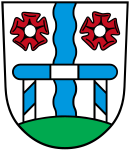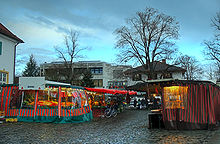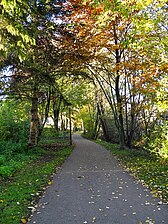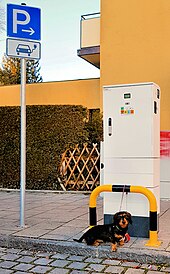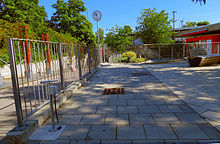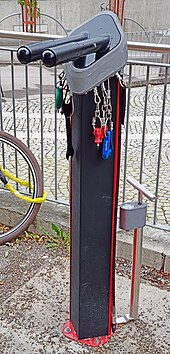Groebenzell
| coat of arms | Germany map | |
|---|---|---|
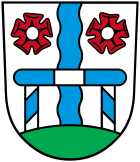
|
Coordinates: 48 ° 12 ' N , 11 ° 22' E |
|
| Basic data | ||
| State : | Bavaria | |
| Administrative region : | Upper Bavaria | |
| County : | Fürstenfeldbruck | |
| Height : | 506 m above sea level NHN | |
| Area : | 6.36 km 2 | |
| Residents: | 20,029 (Dec. 31, 2019) | |
| Population density : | 3,151 inhabitants per km 2 | |
| Postal code : | 82194 | |
| Area code : | 08142 | |
| License plate : | FFB | |
| Community key : | 09 1 79 126 | |
| LOCODE : | DE GZE | |
| Address of the municipal administration: |
Danziger Strasse 23 82194 Groebenzell |
|
| Website : | ||
| Mayor : | Martin Schäfer (UWG Gröbenzell) | |
| Location of the community of Gröbenzell in the Fürstenfeldbruck district | ||
Gröbenzell is a municipality and a village in the Upper Bavarian district of Fürstenfeldbruck and is located about 16 kilometers northwest of Munich city center on the edge of the Graßlfinger / Dachauer Moos . The southern outskirts merge seamlessly into the neighboring town of Puchheim . The eastern edge of the village borders directly on the Munich district of Lochhausen . Gröbenzell unofficially describes itself as a garden city , which mainly serves to market the municipality. Groebenzell is one of the most densely populated municipalities in Germany and is the largest municipality in terms of population in the Fürstenfeldbruck district without municipal rights.
Gröbenzell was founded in 1952 as a political municipality. The (rather poor) districts of Munich , Puchheim, Olching and Geiselbullach were merged into one place around the Gröbenzell railway station. Gröbenzell is one of the “green surrounding communities” of Munich, with many single-family houses, three elementary schools, a high school, a large number of childcare facilities and a Waldorf school . Both retail and manufacturing are located in the industrial area.
Neighboring communities
The distance information describes the straight line to the center of the neighboring town and is commercially rounded to whole kilometers .
|
Olching 4 km |
Market Indersdorf 24 km |
Dachau 11 km |
|
Fürstenfeldbruck 11 km |

|
Karlsfeld 11 km |
|
Eichenau 6 km |
Puchheim 3 km |
Munich 16 km |
history
Until the 19th century
Around 1560, Duke Albrecht V had the "Gröbenhüterhaus" built, which served as the sovereign customs office until the beginning of the 19th century. The first written mention of Gröbenzell goes back to the year 1725. According to this, the name "Gröbenzell" derives from the customs officer from Gröbenbach ("Gröbenzoll"). It was a single house on Gröbenbach, from which the construction of a new road between Lochhausen and Olching should be monitored. The municipal coat of arms therefore also shows a customs barrier over a stream.
At the beginning of the 19th century, the place Gröbenzell emerged from a loose collection of very poor moss and bog settlements.
The first private houses were not built until the middle of the 19th century. The construction of the railway line from Munich to Augsburg in 1840 was associated with an upswing in peat cutters, who were now able to sell their product to the Royal Bavarian State Railways and so a stop was even set up in November 1898.
Until the Second World War, Groebenzell was mainly a peat cutter settlement. Then there were a number of (now largely demolished) resettlement and refugee houses.
Church planting
As a political municipality, Gröbenzell was not constituted until August 1, 1952, when parts of the municipality of the state capital Munich and the municipalities of Geiselbullach, Olching and Puchheim were ceded. The so-called modern Groebenzell emerged in the 1960s and 1970s with the former EIWO (now euphemistically "Alpenland") settlement, which comprises around 250 row houses . These and subsequent settlements made Groebenzell a dormitory city for Munich.
21st century
On April 3, 2011, the voters decided in a referendum on whether Gröbenzell, like the neighboring communities of Olching and Puchheim, should seek city status. With a turnout of almost 52 percent, the citizens decided against it.
Population development
Between 1988 and 2018 the municipality grew from 17,833 to 19,967 by 2,134 inhabitants or by 12%.
The following population figures refer to the area as of May 25, 1987.
| Population development | ||||||||||||
|---|---|---|---|---|---|---|---|---|---|---|---|---|
| year | 1939 | 1950 | 1961 | 1970 | 1987 | 1991 | 1995 | 2000 | 2005 | 2010 | 2015 | 2019 |
| Residents | 2,743 | 5,283 | 6,946 | 11,386 | 17,504 | 18,317 | 18,418 | 18,830 | 19.202 | 19,512 | 19,780 | 20,048 |
The increase in residents continued and rose to 20,048 as of March 31, 2019.
politics
Municipal council
The council Gröbenzells counts due to the more than 20,000 people since the municipal election held on 15 March 2020 for the first time 30 seats (previously 24) and is composed as follows:
- CSU : 9 seats (+1)
- SPD : 4 seats (0)
- Green : 7 seats (+2)
- FW : 2 seats (0)
- UWG: 7 seats (+3)
- FDP : 1 seat (0)
In brackets the changes compared to the municipal council elections in March 2014. The number of eligible voters was 15,917. The turnout was 62.82 percent.
mayor
The incumbent First Mayor is Martin Schäfer ( UWG ). This replaced Dieter Rubenbauer (CSU) on May 1, 2014. In the runoff election on March 29, 2020, he was re-elected with almost 54%. Martin Runge (Bündnis 90 / Die Grünen) holds the position of Second Mayor , and that of Third Mayor Gregor Freiherr von Uckermann (SPD).
A rented office building at Danziger Straße 23 currently serves as the town hall. The new town hall building currently under construction at the previous location in the center was designed by Behnisch Architects . In 2018 all buildings of the previous town hall were demolished. The eastern, older part of the town hall was built in the 1950s, the western town hall extension from 1972 was designed by the architect Götz-Dieter Raths.
The first mayor after the community was founded was the SPD politician Bernhard Rößner , who held this office from 1952 to 1957. A street in Groebenzell and informally the elementary school in this street are named after him. Because of Rößner's membership in the NSDAP, there is resistance in the local council to the official naming of the school with the name of Rößner.
badges and flags
The Groebenzell coat of arms was introduced on the occasion of the 10th anniversary celebration in 1962 by a municipal council resolution. It shows the historically derived white-blue customs barrier. Behind it a blue wavy band that symbolizes the Gröbenbach . The two red heraldic roses on the left and right on the upper edge of the coat of arms refer to Gröbenzell's character as a garden city. The green soil symbolizes the originally extensive moorland south of the Dachauer Moos . The coat of arms was designed by Klemens Stadler , who was the head of the heraldry department at the Bavarian Main State Archives . At the same time as the coat of arms, the municipal council decided on the appearance of the municipal flag. The banner is divided lengthways white and green with the community coat of arms in the middle.
Economy and trade
In the eastern part of the village, between the railway line and the state road to Lochhausen , the Gröbenzell industrial area was created. In addition to the usual supermarkets and discounters, there are various craft and small industrial businesses.
In the town center around Kirchenstrasse and Bahnhofsstrasse there is a supermarket and various drugstores, as well as several bakeries and pastry shops. Among other things, pharmacies, opticians, fruit and vegetable dealers complete the local range of goods and services.
The well-frequented Friday weekly market in Rathausstrasse with a wide range of meat, fish and sausage products as well as fruit, vegetables, flowers, cheese, bread and other things complements the everyday range of goods.
Attractions
- The local history and peat museum, sponsored by the “Gröbenhüter” association, is centrally located opposite the town hall on the top floor of the “Alte Schule” restaurant.
- Catholic Church of St. Johann Baptist, Groebenzell's landmark (built 1925)
- Evangelical Zacchaeus Church from 1955
- New Apostolic Church in the north of Groebenzell (Finkenstrasse)
- The approximately 1.50 meter high bronze figure Sterntaler by the sculptor and ceramist Ferdinand Auerhammer. The figure represents the girl from the fairy tale Die Sterntaler by the Brothers Grimm , who holds up his skirt to catch the silver coins falling from the night sky. These coins are sculpted and have different types of coinage. One shows the production year 1965, another the inscription: "The architect + artists". In addition to the sculptors Arno Visino and Wolf Hirtreiter , as well as the architect Götz-Dieter Raths, a coin was also dedicated to Josef Fottner with the embossing “Kunstmaler Fottner”. The sculpture originally served as a fountain figure, on the raised skirt of which several jets of water met. Its original location was to the right of the savings bank, which also acted as the donor of the work of art. It was later moved to the southern S-Bahn access and became the property of the community of Gröbenzell. After the renovation of the S-Bahn station, the fountain system disappeared, the figure itself has been preserved and is located in the green area opposite the S-Bahn kiosk.
- The " Russenbrücke " with Art Nouveau decor on the northeastern edge of the town (Zillerhofstrasse, near Eschenrieder Strasse), completed in 1916, is Gröbenzell's oldest structure. It was built by French and Russian prisoners of war from the Puchheim camp (Lagerstrasse). The internment camp existed from 1914 to 1920 and was the second largest facility of its kind in Bavaria after Grafenwöhr . An extensive renovation of the bridge took place in 2014.
- Gerhart-Hauptmann- Monument, corner of Puchheimer Strasse and Gerhart-Hauptmann-Platz , designed by the sculptor Herbert Thomas, donated in 1986 by the Silesian Landsmannschaft Gröbenzell
- Since 1993 a forged iron sculpture in front of the post office has been commemorating 260 prisoners who had to do forced labor here during the Second World War, as well as the 80 Italian military internees deployed here. Every year on January 27, the day of remembrance for the victims of National Socialism, a wreath is laid in front of the sculpture.
- There are two bathing lakes in the area of the municipality of Olching near the northern and north-western town limits . The area is very popular with cyclists, joggers and walkers all year round. The southern part of the Munich – Augsburg railway line is known as the Kleiner See or Gröbenzeller See . It is uncultivated and is used as a nudist area on the east side in summer. The Olchinger See lies north of the railway line . It has a watchtower and is run by two restaurants in summer. There is also a mini golf course on its east side.
- The Villa Zierer of the writer Otto Zierer (1909–1983) is located in Weiherweg . The villa was built in 1956 by the architect Hans von Peschke in a Mediterranean style. The villa is also a popular motif for film and TV productions. Here turned u. a. Martina Gedeck , Eva Pflug , Katharina Böhm , Bully Herbig , Dietmar Schönherr , Peter Vogel and the crime scene commissioners Udo Wachtveitl and Miro Nemec .
- The old school built in 1924 opposite the town hall. It started operations in 1925 with 115 students. In 1964 teaching was discontinued. From 1965 to 1992 the building housed a branch of the German Federal Post Office . In the 1990s, a citizens' initiative prevented the building from being demolished. Since 1998, after several renovations, a restaurant as well as the local history and peat museum have been operated in the rooms.
- On March 22, 2012, the artist Gunter Demnig laid one of his stumbling blocks in Bahnhofsstraße 3. The cuboid concrete object with an edge length of around ten centimeters has a brass plate on the top and was set into the pavement in front of the former residence of the Gröbenzell Nazi victim Kurt Schroeter . The electrical engineer, concertmaster and violin teacher lived here with his wife and two daughters. The house was demolished in autumn 2012. The S-Bahn bicycle parking space is now on the site. The engraving on the metal plate shows not only the name but also the life data of the deceased who lived here from 1923 until he was banned from working here in 1937 and who died in Auschwitz in 1944 .
- In the autumn of 2013, a sculpture was created from an approximately 2.50 meter high trunk of a severely damaged chestnut on the Gröbenbach, which was made with the help of a chainsaw. The toolmaker Richard Litzinger called his work of art Fairy Castle . It shows numerous small houses that wind their way up the tree trunk connected by stairs.
- Lüftlmalerei from 1949 on the former train station pharmacy, which was restored in 1980. Only the shown initials GW of the artist are known. The typical work in connection with peat cutting is shown for the area . In autumn 2019, the former train station pharmacy, the old train station restaurant and the surrounding building complex were demolished.
- The approximately 1.60 meter high Bud stele in the foyer of the community center and the four-element fountain in front of the Catholic church by the Groebenzell sculptor Hubert Elsässer .
- During the corona pandemic , a provisional memorial altar for medieval Saint Rochus of Montpellier was built in front of the Catholic Church to the right of the main entrance in spring 2020 . St. Rochus is called in the event of epidemics, plague, cholera and accidents. Among other things, he is the patron saint of sick people, doctors, hospitals and prisoners.
- Sights in and around Groebenzell
Catholic St. Johann Baptist Church ⊙
Evangelical Zacchaeus Church ⊙
New Apostolic Church ⊙
Russenbrücke on the eastern border ⊙
Bronze sculpture Sterntaler ⊙
Gerhart Hauptmann monument ⊙
Bike and walkway on the Kleiner Ascherbach ⊙
Lüftlmalerei on the former train station pharmacy (demolition 2019) ⊙
Olchinger lake on the northwest city limits ⊙
Gröbenzeller See ⊙
Fountain in the leisure area ⊙
Fairy castle on the Gröbenbach

traffic
Street
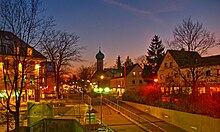
Gröbenzell is connected to the Autobahn 8 via the Dachau / Fürstenfeldbruck or Lochhausen / Langwied junction and to the A 99 via the Munich- Lochhausen / Gröbenzell junction.
 S-Bahn Munich
S-Bahn Munich
In local public transport, Groebenzell has its own stop on the S3 S-Bahn line (Mammendorf – Holzkirchen) and is connected to the S-Bahn network of the Munich Transport and Tariff Association. Munich city center can be reached in around 20 minutes.
 Bus transport
Bus transport
In Gröbenzell there is a bus connection to Lochhausen and Puchheim via the regional bus 830, which connects the S-Bahn stops in both places, and a night line via the night bus N80 / N81 from Pasing train station.
Since November 28, 2016, the MVV regional bus line 832 has been running from Puchheim (S) Nord via Gröbenzell (S) Schubertstraße to Olching (S). Since then, Nord-Gröbenzell, which was previously not connected to the MVV, has been developed.
In 2017, the new MVV RufTaxi 8300 took over the network of the Olching call collective taxi (ASTO).
Since 2019, the Ziegeleiring in Gröbenzell has been served by the express bus route X80 (Puchheim - Gröbenzell - Lochhausen - Obermenzing - Moosach).
Rail infrastructure

The railway line in the direction of Augsburg cuts through Groebenzell from southeast to northwest into a northern and a southern part. Until the beginning of the 1970s, both districts were linked by a restricted level crossing in the extension of Kirchenstrasse to Bahnhofstrasse for general road traffic. Until then, the place also had a freight yard. As part of the redesign of the S-Bahn station, the connecting road between the north and south sections was relocated in the direction of Munich in the form of an underpass in Freyastraße. The full length of Kirchenstrasse then became a one-way street and Bahnhofstrasse in its southern part became a dead end.

Since mid-2012, the Munich-Augsburg train traffic route in particular near the town center has had a noise protection wall . The sound insulation is partially done with graduated green-colored light metal elements. On certain route sections, for example on the track section to the Allach freight station, transparent components are also used in the upper area of the noise protection wall. Various sections of the route receive noise protection in the form of stone-filled wire baskets, so-called gabions . In some places, both types of protective wall are installed alternately and offset, for example in southern Groebenzell along the Lenzweg. The noise protection measures were completed in 2015.
Electromobility
At the corner of Rathaus- Kirchenstraße, to the left of the drugstore, a public charging station of the network operator E-WALD for electric vehicles went into operation at the end of December 2019. A dedicated parking space is reserved for electric cars for charging. According to the municipal council resolution, further stations are planned in the underground car park of the new town hall (from mid-2021) and in Friedensstrasse. Further charging stations are located at Danzinger Straße 15 on the Kaufland car park and at Industriestraße 29 (Bayernwerk Charging Station).
bicycle
Groebenzell was rated comparatively well in several ADFC bicycle climate tests . In particular, in school and in traffic to the S-Bahn station, bicycles play a large part, which can be seen from the extensive and well-used parking facilities on all four sides of the S-Bahn station. In an effort to make road traffic bicycle-friendly in the community of Gröbenzell, two stationary bicycle air pumps made of stainless steel with pressure gauges were installed at the S-Bahn station in May 2015 . Both at the north and south access to the S-Bahn there is a wheel pump at the beginning of the wheel and pedestrian underpass. The stainless steel bicycle pumps were supplemented by a tool column with the most important cyclist tools such as open-ended wrenches, Phillips screwdrivers or Allen wrenches. Gröbenzell has been a member of the AGFK Bayern since 2016 .
schools

State schools
- Ährenfeldschule, elementary school
- Elementary school on Bernhard-Rößner-Straße
- Gröbenzell grammar school
- Gröbenbachschule Gröbenzell, elementary and secondary school with around 280 students (name until 2000: primary and secondary school on Hans-Kerle-Straße, before that until 1995 Hans-Kerle-Schule ). The school was originally named after the founder of the school property. When Hans Kerle's party-political entanglements during the Nazi era became known in the 1990s, the school was renamed. The street name was retained.
Private schools
- Rudolf Steiner School Gröbenzell ( Waldorf School )
Sports
The women's handball club HCD Gröbenzell , which even played in the second division in the 2017/18 season, is the most successful sports club in the municipality.
Well-known Groebenzeller
Science and economy
- Rudolf Bayer (* 1939), Ph.D., database pioneer and inventor of the B-trees , Prof. Emeritus of the Technical University of Munich
- Karl Eibl (1940–2014), literary scholar and professor emeritus at LMU Munich
- Burkhard Göschel (* 1945), former Head of Development and Production at BMW Group AG, Professor of Mechanical Engineering, Chairman of the Formula 1 Manufacturers' Association (GPMA), former Head of Technology at Magna International in Graz (Austria)
- Karl Larenz (1903–1993), well-known legal scholar and full professor at the Ludwig Maximilians University
Art, culture, church
- Monika Baumgartner (* 1951), actress
- Karl-Dieter Bodack (* 1938), engineer and designer
- Hans Bergel (* 1925), writer
- Hubert Elsässer (1934–2009), sculptor
- Wolf Euba (1934–2013), reciter, radio play speaker, director and author
- Josef Fottner (1909–1983), painter
- Martin Gregor-Dellin (1926–1988), writer
- Tilman Jeremias (* 1966), Protestant bishop
- Ulrich Kaiser (1934–2015), sports journalist
- Otto Koch (* 1949), cook and specialist book author
- Werner Tiki coastal maker (* 1953), Protestant pastor, author and cartoonist
- Günter Mack (1930–2007), actor
- Volker Prechtel (1941–1997), theater, cinema, Hollywood ( The Name of the Rose ) and television actor
- Barbara Schöneberger (* 1974), television presenter
- Otto Zierer (1909–1983), non-fiction author, novelist
- Joachim Willeitner (* 1957), non-fiction author, journalist
Sports
- Hans Siegl (1944–1978), motorcycle track racer
- Marco Hiller (1997), professional soccer player
politics
- Reinhold Bocklet (* 1943), lawyer, former Bavarian State Minister D. for food, agriculture and forestry, former member of the Bavarian state parliament
- Peter Glotz (1939–2005), publicist, scientist and SPD politician
- Martin Runge (* 1958), Member of the Bavarian State Parliament from 1996 to 2013, publicist, since 2014 Second Mayor of Gröbenzell
Partner communities

-
 Pilisvörösvár , Hungary (since 1990)
Pilisvörösvár , Hungary (since 1990) -
 Garches , France (since 1994)
Garches , France (since 1994)
Web links
- Local government
- Gröbenzell: Official statistics of the LfStat (PDF; 1.7 MB)
literature
- H. Hell Heimatbuch Grübenzell - A review in words and pictures. Gröbenzell 1982. (1st edition 120 pages)
- H. Hell Heimatbuch Grübenzell - A review in words and pictures. Gröbenzell 1996. (2nd extended edition 120 pages)
- H. Geigenfeind: Pictures from the old Groebenzell . Gröbenhüter, Gröbenzell 1998 (1st edition)
- H. Geigenfeind, A. Kammerl: Stories from the old Groebenzell. Arkaden Verlag, Gröbenzell 1996 ISBN 3-9801476-4-9 (212 pages)
- K. Lehnstaedt: 1945 - end of the war in Gröbenzell. Gröbenhüter, Gröbenzell 2006 (32 pages)
- K. Lehnstaedt, Gröbenhüter Gröbenzell Ed .: Gröbenzell in the years 1933 to 1945. Volk Verlag, Munich 2015 ISBN 978-3-86222-178-3 (296 pages)
- Chronicle of Groebenzell. 30 years of the Groebenzell settlement, Groebenzell interest group, Hans Kaiser, Olching 1931 (40 pages)
- Groebenzell - the blossoming garden city - yearbook 1956–1957. (68 pages)
- 10 years of the community of Gröbenzell. Groebenzell 1962 (90 pages)
- Community of Gröbenzell - Chronicle of an aspiring community. Community of Gröbenzell 1977. (76 pages, published as hardcover and brochure)
- Gröbenzell Grammar School - 25th anniversary celebration - yearbook. Grammar school Gröbenzell 2006. (243 pages)
Individual evidence
- ↑ "Data 2" sheet, Statistical Report A1200C 202041 Population of the municipalities, districts and administrative districts 1st quarter 2020 (population based on the 2011 census) ( help ).
- ↑ Description and history of the municipal coat of arms Entry on the coat of arms of Gröbenzell in the database of the House of Bavarian History
- ^ Wilhelm Volkert (ed.): Handbook of Bavarian offices, communities and courts 1799–1980 . CH Beck'sche Verlagsbuchhandlung, Munich 1983, ISBN 3-406-09669-7 . Page 466
- ^ Voting result of the referendum of April 3, 2011
- ↑ Announcement of the population figures , on the website of the municipality of Gröbenzell, accessed on November 12, 2019.
- ↑ Mayor. Community of Gröbenzell, accessed on August 6, 2020 .
- ↑ Legal position of the mayor according to municipal law (on www.groebenzell.de)
- ↑ New town hall building. Retrieved December 6, 2018 .
- ↑ Historical street names in Groebenzell . Gröbenzell community. Retrieved April 5, 2011.
- ^ Peter Bierl : New name for school wanted , Süddeutsche Zeitung . November 24, 2010. Retrieved April 5, 2011.
- ↑ Description of the Groebenzell municipal flag
- ↑ Memorial sites for the victims of National Socialism. A documentation. Volume 1. Federal Agency for Civic Education, Bonn 1995, ISBN 3-89331-208-0 , p. 143.
- ^ Villa Zierer, Art and Literature in the West of Munich
- ↑ Süddeutsche.de , A bow to the victims , March 23, 2012 (accessed April 27, 2012)
- ↑ Merkur Online , Groebenzell gets a stumbling block (accessed on April 28, 2012)
- ↑ Night lines in the MVV ( Memento of the original from December 5, 2010 in the Internet Archive ) Info: The archive link was automatically inserted and not yet checked. Please check the original and archive link according to the instructions and then remove this notice.
- ↑ Münchner Merkur: Master plan for electric charging stations from July 22, 2019 (accessed on January 7, 2020)
- ↑ Homepage of the community of Gröbenzell on the new bicycle pumps
- ^ TU Munich, Chair of Prof. Bayer, Ph.D









